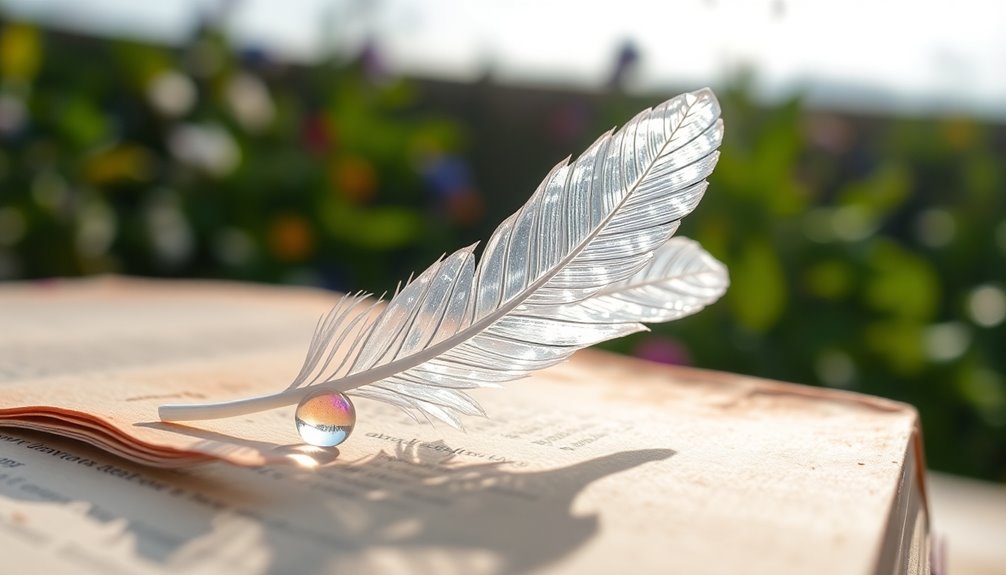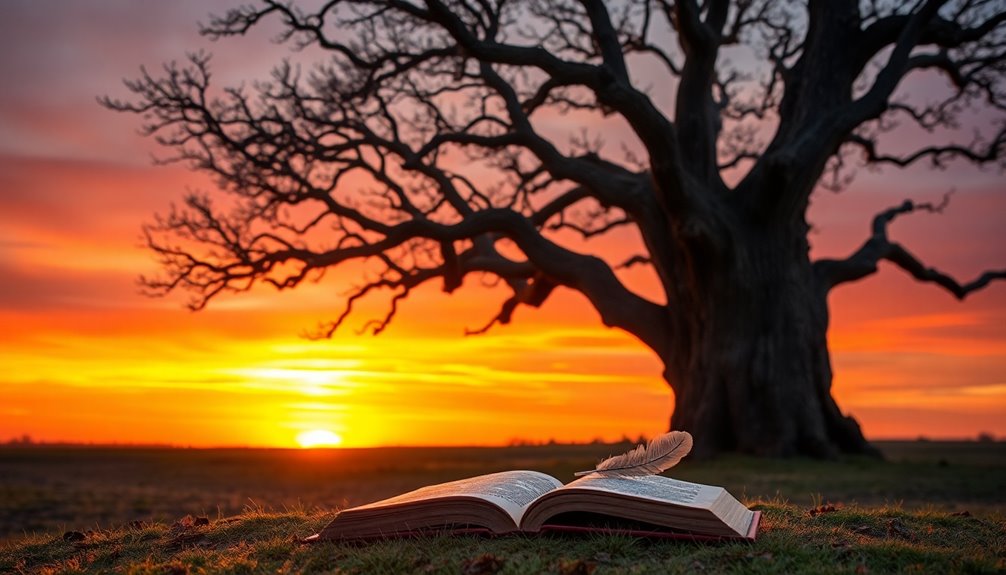Symbolism is when everyday things like objects, colors, or animals stand for bigger ideas. For instance, a red rose usually means love, while a dove represents peace. In stories, symbols can change meaning as the plot unfolds, like the green light in *The Great Gatsby* that symbolizes dreams. You can also see symbolism in colors; blue might show calmness, while red can express anger. Understanding these symbols can make your connection to a story richer and more exciting. So, keep an eye out for symbols next time you enjoy a tale, and you might discover even more hidden meanings!
Key Takeaways
- Symbolism transforms objects, characters, or colors into representations of larger abstract ideas, enriching literature with deeper meanings.
- Common examples include a red rose symbolizing love and a dove representing peace.
- The green light in *The Great Gatsby* symbolizes unattainable dreams, evolving in meaning as the story progresses.
- The conch shell in *Lord of the Flies* signifies order and civilization, highlighting the importance of structure in society.
- Color symbolism, such as red for passion or blue for calmness, conveys emotions and themes within narratives.
Definition of Symbolism

Symbolism is a powerful literary device that transforms everyday objects, characters, or colors into representations of larger, abstract ideas. When you immerse yourself in a story, you might notice how authors use symbols to create meaning beyond the literal.
For instance, a red rose often represents love and passion, while a dove signifies peace and tranquility. These common examples of symbolism help you understand the deeper themes in the text.
Symbols can change in meaning as the story unfolds. Take the green light in *The Great Gatsby*; it symbolizes unattainable dreams, reflecting the character's growth. Some symbols are easy to spot, like the conch shell in *Lord of the Flies*, which represents order and civilization.
Others may need a bit more thought to uncover their significance. Understanding symbolism enriches your reading experience, allowing you to engage with the text on multiple levels.
You'll uncover hidden meanings and emotional connections that make stories come alive. So, the next time you read a book, keep an eye out for these symbols. You might just discover a whole new layer of meaning waiting for you!
Types of Symbolism

In literature, various types of symbolism enrich the narrative by linking tangible elements to abstract ideas. These symbols help us navigate complex concepts and add depth to stories. Let's explore some widely used types of symbolism:
| Type of Symbolism | Examples |
|---|---|
| Color Symbolism | Red symbolizes love or anger; blue represents calmness or sadness. |
| Animal Symbolism | Doves symbolize peace; lions represent strength and courage. |
| Common Object Symbolism | A wedding ring represents eternal commitment; a key symbolizes access. |
Physical object symbolism includes items that signify important ideas. For instance, in *Lord of the Flies*, a conch shell symbolizes order and civilization. Event symbolism also plays a role, where specific events like a quinceañera represent a girl's change into womanhood in many Latin American cultures.
These types of symbolism create a rich tapestry in storytelling. They allow you to see beyond the surface and discover deeper meanings. So, next time you read a story, keep an eye out for these symbols, and you might just find a treasure trove of ideas waiting to be uncovered!
Recognizing Symbolism

Recognizing symbolism in literature opens up a world of deeper meanings and insights. When you notice objects, characters, or events that represent something else, you're tapping into the magic of symbolism!
For example, a dove commonly used in stories symbolizes peace. Keep an eye out for repeated images or themes; these often signal that the author wants you to explore deeper meanings.
Think about color, too! A character with the color green in their eyes might symbolize jealousy, helping you find clues about their motivations. The context is essential; the same symbol can have different meanings depending on the surrounding events.
Don't worry if you miss some symbols the first time you read a story. Engaging with the text multiple times can reveal subtle symbols that enhance your understanding.
Each reading offers new opportunities for interpretation, making the moral of the story even richer.
Functions of Symbolism

Through its various functions, symbolism enriches literature, inviting you to explore complex themes and ideas. Symbolism is often used to symbolize deeper meanings, where one thing represents another. This might be a physical object, like a rose symbolizing love, or a character that embodies bravery. The functions of symbolism allow writers to convey abstract ideas in a clear and engaging way.
You'll find a wide variety of types of symbolism throughout stories. For example, recurring motifs signal important messages, helping you connect with the narrative. The imagery created by symbols can evoke specific moods, making your reading experience more vivid and emotional.
In character development, symbolism reveals traits and motivations, providing insights into their struggles and growth. When you see how a character interacts with a symbol, you gain a better understanding of their journey. This layered meaning encourages you to think critically and dive deeper into the story.
Examples of Symbolism

Symbolism weaves rich layers into literature, bringing deeper meanings to the forefront. Writers use symbolism to create powerful connections between objects and ideas. For example, in *The Great Gatsby*, the green light at the end of Daisy's dock symbolizes Gatsby's dreams and hopes, making readers feel his longing.
In Nathaniel Hawthorne's *The Scarlet Letter*, the letter "A" represents sin and shame, while also hinting at strength and resilience.
The color red is often associated with passion and love. Think of how red roses symbolize romantic feelings in many stories!
In *Lord of the Flies*, the conch shell stands as a symbol of order and civilization, showcasing the boys' initial attempts to create rules. Meanwhile, in Virginia Woolf's *The Waves*, water symbolizes the flow of life, reflecting characters' changes and growth.
Lastly, the black cat is sometimes a symbol of bad luck, evoking fear or superstition in many cultures.
These examples of symbolism show how writers use objects and colors to convey deeper meanings and emotions. When you spot symbolism in literature, it can make the story even more exciting!
Frequently Asked Questions
What Is Symbolism and Give 5 Examples?
Symbolism is a fun and creative way to give deeper meaning to stories!
When you see a green light in *The Great Gatsby*, it represents dreams that seem out of reach.
In *Animal Farm*, the farm shows how ideas can change over time.
The color white often stands for purity, like a bride's dress.
Blood in *Macbeth* reveals guilt.
These symbols make stories richer and help you connect with the characters' feelings!
What Is Symbolism 3 Examples?
Symbolism is super exciting! It's when things in stories stand for bigger ideas.
For example, in *The Great Gatsby*, the green light shows Gatsby's dreams that he can't reach.
Then, in *Animal Farm*, Boxer the horse represents hard-working people being taken advantage of.
Finally, in *Macbeth*, blood symbolizes guilt and how ambition can lead to bad choices.
These symbols make stories deeper and more meaningful, connecting feelings and ideas effortlessly!
What Is an Easy Example of Symbolism in Literature?
An easy example of symbolism in literature is the green light in *The Great Gatsby*.
Imagine a bright green beacon shining in the distance. It represents Gatsby's dreams, always just out of reach. You can feel his hope and longing, can't you?
Similarly, the conch shell in *Lord of the Flies* symbolizes order among chaos, reminding us how fragile society can be.
These symbols help convey deeper meanings in stories that capture our imagination!
What Is Symbolism?
Symbolism is a fun way writers add deeper meaning to their stories! It uses objects, characters, or colors to represent big ideas.
For example, a dove might stand for peace, while a storm could mean trouble.
When you read, look for these symbols—they help you understand the story better. It's like a treasure hunt for meaning!
Discovering symbols makes reading exciting, as you uncover layers of emotions and themes hidden within the text.
Conclusion
In summary, symbolism is like a treasure chest filled with hidden meanings and surprises! It helps us see the world in a colorful way, making stories and art come alive. By recognizing symbols, you reveal a secret language that adds depth to everything around you. So, next time you read a book or watch a movie, keep an eye out for those magical symbols! They're waiting to share their amazing stories with you. Happy exploring!











